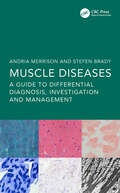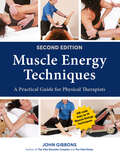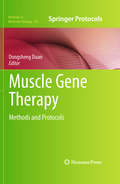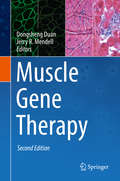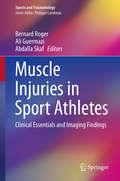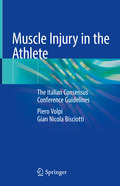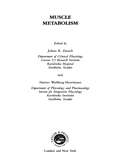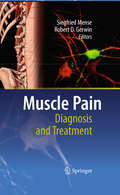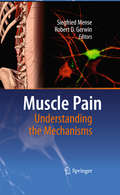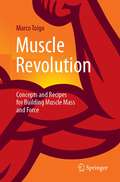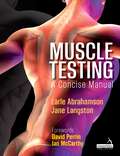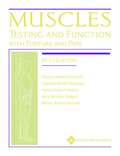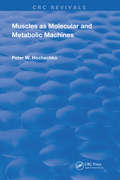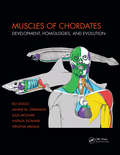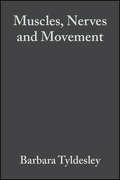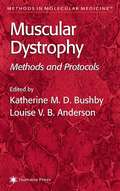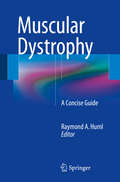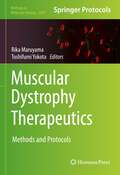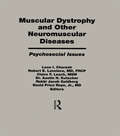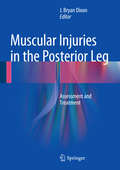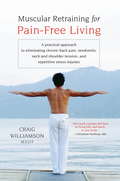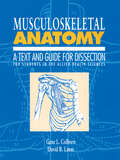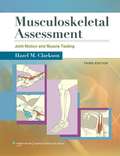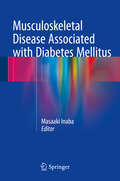- Table View
- List View
Muscle Diseases: A Guide to Differential Diagnosis, Investigation and Management
by Andria Merrison and Stefen BradyThis volume is a how-to guide on the clinical assessment and investigation of patients presenting with muscle-related symptoms. Featuring a case-based approach, this accessible text is suitable for a wide range of clinical specialists who see patients presenting with both common and rare muscle diseases.Muscle diseases are often initially missed or misdiagnosed, as they are uncommon disorders and can present in a variety of ways, often mimicking other more common disorders. Careful assessment of the history, physical examination and appropriate choice of investigations is therefore essential to reaching a diagnosis and providing short- and long-term effective management plans. Key features of this resource include: A case-based approach using real cases seen in clinical practice and highlighting different clinical presentations Case vignettes that cover patient history, examination, investigations, diagnosis and discussion points to assist the reader in developing a mental framework for thinking about muscle disease and approaching diagnosis The relevant investigations (including muscle biopsy, neurophysiology and muscle imaging) required for each clinical scenario, aiding the clinician in clinicopathological correlation Being concise, practical and complemented by a wide range of figures to enhance understanding Patients with muscle diseases may be referred to one of several medical or surgical specialties, including neurology, rheumatology, neuropathology, neurophysiology, cardiology, respiratory medicine, intensive care medicine, gastroenterology, ophthalmology, orthopaedic and spinal surgery, before the correct diagnosis is considered. This accessible text is an ideal resource for clinicians.
Muscle Energy Techniques, Second Edition: A Practical Guide for Physical Therapists
by John GibbonsRevised and updated: a fresh new look to an established best-seller--an essential tool for physical therapists that offers unique insights into the versatile and highly effective technique of muscle energy techniques.Muscle Energy Techniques is a must-have for any student or practitioner of physical therapy, osteopathy, physiotherapy, chiropractic, or massage therapy. This practical guide--packed with full-color photographs and illustrations--fully explains the theory and practice of a range of muscle energy techniques.The book is broken in 5 parts. In part I, John Gibbons examines the theory and principles behind muscle energy techniques, with chapters that explain the technique, muscle imbalances, myofascial slings, and core muscle relationships. Parts II to IV break down the technique by body area--upper body, lower body, trunk, and pelvis--with clear descriptive explanations of the techniques. Accompanied by color photographs with directional arrows, each shows the practitioner how to maximize treatment benefits. Clear drawings allow the reader to understand the basic anatomy of each muscle. A concluding part V shows two applications of muscle energy techniques: self-lengthening techniques for the shoulder complex and muscle weakness testing of the gluteals.
Muscle Gene Therapy
by Dongsheng DuanMuscle disease represents an important health threat to the general population. There is essentially no cure. Gene therapy holds great promise to correct the genetic defects and eventually achieve full recovery in these diseases. Significant progresses have been made in the field of muscle gene therapy over the last few years. The development of novel gene delivery vectors has substantially enhanced specificity and efficiency of muscle gene delivery. The new knowledge on the immune response to viral vectors has added new insight in overcoming the immune obstacles. Most importantly, the field has finally moved from small experimental animal models to human patients. This book will bring together the leaders in the field of muscle gene transfer to provide an updated overview on the progress of muscle gene therapy. It will also highlight important clinical applications of muscle gene therapy.
Muscle Gene Therapy: Methods And Protocols (Methods In Molecular Biology #709)
by Dongsheng Duan Jerry R. MendellAbout 7 million people worldwide are suffering from various inherited neuromuscular diseases. Gene therapy brings the hope of treating these diseases at their genetic roots. Muscle Gene Therapy is the only book dedicated to this topic. The first edition was published in 2010 when the field was just about to enter its prime time. The progress made since then has been unprecedented. The number of diseases that have been targeted by gene therapy has increased tremendously. The gene therapy toolbox is expanded greatly with many creative novel strategies (such as genome editing and therapy with disease-modifying genes). Most importantly, clinical benefits have begun to emerge in human patients. To reflect rapid advances in the field, we have compiled the second edition of Muscle Gene Therapy with contributions from experts that have conducted gene therapy studies either in animal models and/or in human patients. The new edition offers a much needed, up-to-date overview and perspective on the foundation and current status of neuromuscular disease gene therapy. It provides a framework to the development and regulatory approval of muscle gene therapy drugs in the upcoming years. This book is a must-have for anyone who is interested in neuromuscular disease gene therapy including those in the research arena (established investigators and trainees in the fields of clinical practice, veterinary medicine and basic biomedical sciences), funding and regulatory agencies, and patient community.
Muscle Injuries in Sport Athletes
by Ali Guermazi Bernard Roger Abdalla SkafThis book attempts to provide a comprehensive look at all of the pathologies of muscles that are likely to be encountered in treating sports-related injuries. Its purpose is to give the practitioner a guide for identifying injuries and choosing the best therapeutic strategy. The first part presents the consensus view of current knowledge: the physiology of lesions and their prognosis as well as their anatomy, clinical imaging, and treatment. Then each of the muscles is described in turn, with a review of anatomy, clinical examination, the results of imaging, and therapeutic choices for acute and chronic injuries. A major section is dedicated to imaging, with the emphasis on which diagnostic methods are best for specific injuries and how to use diagnostic imaging to determine the most suitable therapeutic strategies. Special care has been taken to provide high-quality illustrations that clearly show how to identify the lesion of the damaged muscle. A wealth of illustrations, many in color, are included. Finally, the book concludes with some clinical cases and technical notes relevant to treatment of sports-related muscle injuries.
Muscle Injury in the Athlete: The Italian Consensus Conference Guidelines
by Piero Volpi Gian Nicola BisciottiThis volume provides a cutting-edge analysis concerning the biology and aetiology, classification, clinical assessment and conservative treatment of lower limb muscle injuries in athletes. Muscle injuries are the most common trauma both in team and individual sports and are responsible for most of the time lost both in training and in competition: in professional football (soccer), they account for 30% and in track and field for 48% of all injuries recorded. Despite the considerable interest in this topic among clinicians and researchers, there is still no consensus regarding the etiopathogenesis, classification, clinical examination and treatment of muscle lesions. Based on the first Italian Consensus Conference on guidelines for the conservative treatment of lower limb muscle injuries in athletes, which was held in April 2017 at Humanitas Clinic Institute in Milan, Italy under the auspices of the Italian Society of Arthroscopy, this comprehensive book addresses the main issues concerning muscle injuries, from biology and pathobiology to clinical evaluation and different treatment option, including the most frequently used physio-kinesitherapy therapies. It also presents a consensus classification of muscle injuries closely linked to prognostic factors. Written by international experts with diverse medical backgrounds, this book offers comprehensive practical guidance for orthopedic surgeons, sports physicians, athletic trainers, physiotherapists, sports science students, and physiatrists.
Muscle Metabolism
by Juleen R. Zierath Harriet Wallberg-HenrikssonDiabetes research on models comprising intact animal tissues, cell cultures and isolated pancreatic islets is essential for understanding the pathogenesis of the disease as well as the mechanisms responsible for the chronic complications associated with it. Enormous advances in the understanding of the development of diabetes and its prevention hav
Muscle Pain: Diagnosis and Treatment
by Robert D. Gerwin Siegfried MenseThe companion volume to Muscle Pain: Understanding the Mechanisms, this text shifts the emphasis from concepts to practical advice. It facilitates the diagnosis and management of the often enigmatic symptoms of chronic muscle pain.
Muscle Pain: Understanding the Mechanisms
by Robert D. Gerwin Siegfried MenseThe two books Muscle Pain: Understanding the Mechanisms and Muscle Pain: Diagnosis and Treatment will help the practitioner to understand why the patients feel pain, what to do about it and why the treatment works. In contrast to proceedings of scientific meetings on muscle pain, they center on practical aspects and can be used by the practitioner in his or her daily work. The two books together provide a unique combination of broad basic knowledge with comprehensive clinical information on the management of patients.
Muscle Revolution: Concepts and Recipes for Building Muscle Mass and Force
by Marco ToigoHow to Effectively and Efficiently Build Muscle Mass and Muscle ForceIn this informative as well as practical book based on the latest integrative muscle research, Marco Toigo, PhD, describes which factors are crucial to successfully build muscle mass and muscle force through resistance training. In addition, he presents the practical and science-based consequences for your training and nutritional behavior with a focus on protein intake. This work thus offers both a practical guide and a scientific explanation of the "why" and "how" of effective and efficient resistance training.This book is the English version of the very successful 2nd German edition of “MuskelRevolution“ (ISBN: 978-3-662-54764-9). The translation was done with the help of artificial intelligence. A subsequent human revision was done primarily in terms of content.
Muscle Testing: A Concise Manual
by Earle Abrahamson Jane LangstonMuscle testing - A Concise Manual, provides a reference for understanding how structure relates to function, and how by knowing function we can learn structural configurations.The book summarises the key anatomical facts and figures, give methods for muscle testing by several techniques, and provides clinically useful information to supplement the tests.
Muscles Testing and Function with Posture and Pain (5th Edition)
by Florence Peterson Kendall Elizabeth Kendall Mccreary Patricia Geise Provance Mary Mcintyre Rodgers William Anthony RomaniThis book intends to provide rehabilitation professionals with a wealth of knowledge and background in the all-important aspect of the patient/client examination process.
Muscles as Molecular and Metabolic Machines (Routledge Revivals)
by Peter W. HochachkaFirst published in 1994, this book explores the paradigm of muscles as molecular and metabolic machines in which all structures and functions are exquisitely integrated and matched to each other. The analysis begins with a standard reductionist approach-reviewing the integrated machine parts. The key working components of the complete muscle machine are proteins (soluble, organelle, or membrane localized), and a conservative count indicates that today more than 100 such machine parts are known, essentially all occurring as cell specific isoforms. Random assortment of these machine parts or protein isoforms could generate an astronomical number of "muscle machines" and an equally enormous number of muscle fiber types. The question is, why aren't such large numbers ever seen?To attack this problem, the reductionist approach is complemented with an integrationist/adaptational one. Evidence is presented that the more highly specialized the muscle type, the further one moves from the above extreme; in the most highly specialized muscles, typically only one fiber type is found. It is argued that instead of random assortment of isoforms or machine parts, only specific and often unique combinations can work in appropriate fashion. A few established examples of this fundamental principle are reviewed, but emphasis is placed on the fact that we know dreadfully little about why this is so and what kinds of further studies are needed. The issue of why the very large numbers of fiber types theoretically possible are never even approximately realized has never before been addressed. Indeed, it is rarely recognized. Muscles as Molecular and Metabolic Machines is the first work of its kind on the subject.
Muscles of Chordates: Development, Homologies, and Evolution
by Rui Diogo Julia Molnar Janine M. Ziermann Natalia Siomava Virginia AbdalaChordates comprise lampreys, hagfishes, jawed fishes, and tetrapods, plus a variety of more unfamiliar and crucially important non-vertebrate animal lineages, such as lancelets and sea squirts. This will be the first book to synthesize, summarize, and provide high-quality illustrations to show what is known of the configuration, development, homology, and evolution of the muscles of all major extant chordate groups. Muscles as different as those used to open the siphons of sea squirts and for human facial communication will be compared, and their evolutionary links will be explained. Another unique feature of the book is that it covers, illustrates, and provides detailed evolutionary tables for each and every muscle of the head, neck and of all paired and median appendages of extant vertebrates. <P><P> Key Selling Features: <li>Has more than 200 high-quality anatomical illustrations, including evolutionary trees that summarize the origin and evolution of all major muscle groups of chordates <li>Includes data on the muscles of the head and neck and on the pectoral, pelvic, anal, dorsal, and caudal appendages of all extant vertebrate taxa <li>Examines experimental observations from evolutionary developmental biology studies of chordate muscle development, allowing to evolutionarily link the muscles of vertebrates with those of other chordates <li>Discusses broader developmental and evolutionary issues and their implications for macroevolution, such as the links between phylogeny and ontogeny, homology and serial homology, normal and abnormal development, the evolution, variations, and birth defects of humans, and medicine.
Muscles, Nerves and Movement: In Human Occupation
by June Grieve Barbara TyldesleyThis book has established itself as the leading textbook for the study of movement by occupational therapists. Two senior tutors in occupational therapy act as consultants on this new third edition. The early chapters provide a foundation for the study of movement with the complexity of detail increasing as the book progresses. The functional anatomy is related to the movements of daily living and is supported by activities for experiencing and observing the way we perform everyday tasks. The later chapters consider the integration of sensory and motor processes in the nervous system for the planning and execution of movement. Clinical note-pads link the basic knowledge to the clinical features of common orthopaedic and neurological problems.
Muscular Dystrophy
by Katherine M.D. Bushby Louise V.B. AndersonKatherine Bushby and Louise Anderson assemble an outstanding collection of key techniques for the analysis of DNA and protein from patients suspected to suffer from muscular dystrophy. Each method is highly detailed to ensure success and is presented by a hands-on expert. The various DNA techniques focus on both the X-linked muscular dystrophies and the autosomal recessive muscular dystrophies. The protein methods include expression analysis, multiplex western blot analysis, immunocytochemical analysis, and reviews of immunological reagents and of amplification systems. Comprehensive and highly practical, Muscular Dystrophy: Methods and Protocols offers today's diagnostic laboratories, basic and medical researchers, and clinicians an authoritative collection of tools that will serve as exacting diagnostic tools as well as greatly empowering research on the novel therapeutics now beginning to emerge.
Muscular Dystrophy
by Raymond A. HumlThis practical and concise guide offers an overview of muscular dystrophy's complicated features, treatment options and general resources. New treatments and a greater understanding of proteins and structures associated with MD are discussed along with long term patient care. Also included are clinical and developmental challenges within the current regulatory landscape and recent scientific and clinical advances. Muscular Dystrophy offers clinicians, researchers, pharmaceutical executives and patient advocacy groups an easy-to-read reference that provides the necessary perspectives of the care giver and patient.
Muscular Dystrophy Therapeutics: Methods and Protocols (Methods in Molecular Biology #2587)
by Toshifumi Yokota Rika MaruyamaThis detailed book presents a comprehensive collection of state-of-the-art protocols on muscular dystrophy therapeutics, covering therapeutics using antisense oligonucleotides, gene replacement, genome editing, small molecules, stem cells, and antibodies. Written by leaders in the field, the volume explores techniques that are currently in use and are starting an exciting therapeutic revolution in muscular dystrophy. As a part of the highly successful Methods in Molecular Biology series, chapters include introductions to their respective topics, lists of the necessary materials and reagents, step-by-step and readily reproducible laboratory protocols, as well as tips on troubleshooting and avoiding known pitfalls. Authoritative and practical, Muscular Dystrophy Therapeutics: Methods and Protocols serves as an ideal resource to inspire readers and provide tips, strategies, and advice to develop new therapeutic technologies for this group of diseases.
Muscular Dystrophy and Other Neuromuscular Diseases: Psychosocial Issues
by Austin H. Kutscher Leon I. Charash Robert E. Lovelace Claire F. Leach Rabbi Jacob Goldberg David Price RoyeHere is a thoughtful new book for professionals who assist persons afflicted with neuromuscular disorders to help them and their families adapt to lifestyle changes accompanying the onset of these disorders. Health care professionals provide strategies to maintain the psychosocial well-being of children and adults with neuromuscular disorders which, in addition to physical damage, also assault the sense of self and challenge the individual’s ability to move and communicate. Chapters describe the psychosocial aspects of a variety of neuromuscular diseases such as Duchenne and myotonic muscular dystrophy, multiple sclerosis, amyotrophic lateral sclerosis, Friedeich’s ataxia, and Charcot-Marie-Tooth disease. The distinctive characteristics of each disease are examined with special attention given to the natural history, treatment, management, and psychosocial issues of the specific disorder. Beyond the clinical and research importance of Muscular Dystrophy and Other Neuromuscular Diseases, it also addresses the anxiety, doubts, and questions felt by patients with chronic progressive disabilities and their families. This helpful guide is unique in the way it features the interaction of professionals in the social services, psychology, religion, and various medical specialties in the care and treatment of these patients. Professionals in all of these disciplines, as well as the patients and families afflicted by these disorders, will benefit from this valuable resource.
Muscular Injuries in the Posterior Leg
by J. Bryan DixonTaking a multidisciplinary approach to a common and often frustrating problem for athletes and those with an active lifestyle, this book is the first of its kind, addressing muscular injuries to the posterior leg using an in-depth and expansive style that is uniquely dedicated to ensuring all content is explicitly linked to the practical care of patients with calf pain. It is divided thematically into three sections. The first section covers underlying principles involved in these issues, including anatomy, physiology, pathophysiology of injury and neurophysiology of musculoskeletal pain. Clinical assessment techniques and imaging are covered in the second section. The third section on treatment is the most expansive, discussing acute, sub-acute and chronic posterior leg muscle injuries, as well as surgical management, rehabilitation techniques, complementary medicine and special populations. Overall, the book is designed to use muscular injuries of the posterior leg to as a means to understand the assessment and treatment of muscular injuries more broadly. Taken together, it is the consummate source for orthopedists, doctors in sports medicine, podiatrists, rehabilitation professionals and primary care physicians who treat muscular injuries in the posterior leg, though reader will gain a conceptual and practical framework for the assessment and treatment of muscular injuries in general.
Muscular Retraining for Pain-Free Living
by Craig WilliamsonHere's an innovative and practical approach to eliminating chronic muscle pain, written by a popular occupational therapist with thirty years of experience freeing people from the discomfort of tendonitis, lower back pain, and neck and shoulder tension. These types of chronic pain can be caused by a number of factors, including old injuries, habitual movement patterns, problems with body alignment, psychological causes, and inability to sense your own body movements accurately. Muscular Retraining for Pain-Free Living clearly and concisely explains the causes of persistent muscle pain and offers a therapeutic exercise program to address these problems and end pain. This book explains the basic principles behind Williamson Muscular Retraining, which helps people to use their bodies more efficiently and gracefully, in a way that is practical and easy to understand. The problems of poor posture, muscle tension, and stress-caused pain are corrected by seeing them through the lens of kinesthetic awareness. The importance of kinesthetic awareness is typically overlooked precisely because it is lacking in so much of our population, including health care practitioners. Retraining for Pain-Free Living presents case examples of how people have used body awareness to improve how they sit, stand, and move - to rid themselves of ongoing muscular pain.
Musculoskeletal Anatomy
by Gene L. Colborn D.B. LauseThis book is a guide for the dissection of the back and limbs - regions which are specifically relevant in the education of students in occupation and physical therapy. It contains data pertinent to many of the structures which are to be examined in the gross anatomy laboratory.
Musculoskeletal Assessment: Joint Motion and Muscle Testing (Third Edition)
by Hazel M. ClarksonA comprehensive textbook that contains the principles and methodology of joint Range of Motion (ROM) and manual muscle strength evaluation in one volume.
Musculoskeletal Assessment: Joint Range of Motion, Muscle Testing, and Function
by Hazel ClarksonDevelop the skills needed to proficiently evaluate a patient’s present functional status and create effective range of motion and muscle strength goals. <p><p> This updated fourth edition of Hazel Clarkson’s Musculoskeletal Assessment: Joint Range of Motion, Muscle Testing, and Function: A Research-Based Practical Guide offers a straight forward student-friendly approach to learning the clinical evaluation of Joint Range of Motion (ROM), Muscle Length, and Manual Muscle Testing (MMT). Now in striking full color, the fourth edition provides the right amount of detail students need to prepare for effective practice. <p><p> Each chapter is devoted to a separate anatomical region to help Physical Therapists and Occupational Therapists-in-training hone their understanding of pertinent surface and deep anatomy. The clear narrative outlines the steps taken in the assessment techniques and interpreting the results and is enhanced by a strong art program with meticulously created color illustrations and photographs that demonstrate patient and therapist positions and instrument placement.
Musculoskeletal Disease Associated with Diabetes Mellitus
by Masaaki InabaThe aim of this book is to review the latest findings on musculoskeletal disease associated with diabetes. It has been increasingly recognized that maintaining skeletal health is an important factor in achieving longevity in healthy subjects. Diabetes has been established as a disease independently associated with sarcopenia and increased risk of bone fracture resulting from osteoporosis; therefore, it is reasonable to maintain that musculoskeletal health is important in preserving good health. As either bone or muscle is intimately involved in the regulation of metabolic status, keeping the musculoskeletal system healthy is important for improving abnormal glucose metabolism toward normal levels and is vital, as well, for maintaining normal activities of daily living. Muscle is a target of insulin for enhancing the entry of glucose; thus it is conceivable that sarcopenia and muscle containing fat streaks causes insulin resistance in diabetic patients. Furthermore, bone is an organ that regulates Ca and Pi levels in serum by releasing or resorbing Ca and Pi to and from bone tissue. It is now known that bone is a definitive endocrine organ for regulating glucose metabolism and Pi metabolism by secreting osteocalcin and FGF-23 from osteocytes/osteoblasts. Readers will learn of the recent findings in this area, and this book will benefit physicians who deal with diabetes, particularly orthopedists and bone specialists, as well as all physical therapists.
